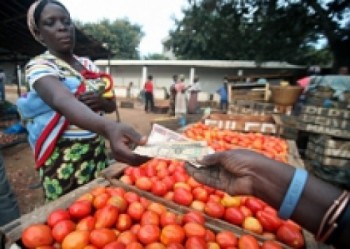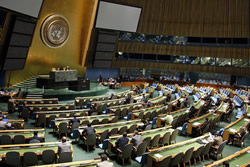World hunger report 2011: High, volatile prices set to continue …
World hunger report 2011: High, volatile prices set to continue 10-10-2011
Heads of Rome-based UN food agencies call for forceful action
Food price volatility featuring high prices is likely to continue and possibly increase, making poor farmers, consumers and countries more vulnerable to poverty and food insecurity, the United Nations’ three Rome-based agencies said in the global hunger report published today.
 Small, import-dependent countries, particularly in Africa, are especially at risk. Many of them still face severe problems following the world food and economic crises of 2006-2008, the UN Food and Agriculture Organization (FAO), the International Fund for Agricultural Development (IFAD) and the World Food Programme (WFP) said in “The State of Food Insecurity in the World 2011” (SOFI), an annual flagship report which they jointly produced this year.
Small, import-dependent countries, particularly in Africa, are especially at risk. Many of them still face severe problems following the world food and economic crises of 2006-2008, the UN Food and Agriculture Organization (FAO), the International Fund for Agricultural Development (IFAD) and the World Food Programme (WFP) said in “The State of Food Insecurity in the World 2011” (SOFI), an annual flagship report which they jointly produced this year.
Such crises, including in the Horn of Africa, “are challenging our efforts to achieve the Millennium Development Goal (MDG) of reducing the proportion of people who suffer from hunger by half in 2015,” the heads of the three agencies — Jacques Diouf of FAO, Kanayo F. Nwanze of IFAD and Josette Sheeran of WFP — warned in a preface to the report.
Never acceptable
“But even if the MDG were achieved by 2015 some 600 million people in developing countries would still be undernourished. Having 600 million people suffering from hunger on a daily basis is never acceptable,” they said.
“The entire international community must act today and act forcefully to banish food insecurity from the planet,” the three heads added.
“Governments must ensure that a transparent and predictable regulatory environment is in place, one that promotes private investment and increases farm productivity. We must reduce food waste in developed countries through education and policies, and reduce food losses in developing countries by boosting investment in the entire value chain, especially post-harvest processing. More sustainable management of our natural resources, forests and fisheries are critical for the food security of many of the poorest members of society,” the three heads said.
High and volatile food prices likely to continue
This year’s report focuses on high and volatile food prices, identified as major contributing factors in food insecurity at global level and a source of grave concern to the international community.
“Demand from consumers in rapidly growing economies will increase, the population continues to grow, and further growth in biofuels will place additional demands on the food system,” the report said.
Moreover, food price volatility may increase over the next decade due to stronger linkages between agricultural and energy markets and more frequent extreme weather events.
Smallholders and poor consumers
Price volatility makes both smallholder farmers and poor consumers increasingly vulnerable to poverty while short-term price changes can have long-term impacts on development, the report found. Changes in income due to price swings that lead to decreased food consumption can reduce children’s intake of key nutrients during the first 1000 days of life from conception, leading to a permanent reduction of their future earning capacity and an increased likelihood of future poverty, with negative impacts on entire economies.
But price swings affected countries, populations and households very differently, the report found. The most exposed were the poor and the weak, particularly in Africa, where the number of undernourished increased by 8 percent between 2007 and 2008 while it was essentially constant in Asia.
Some large countries were able to shelter their food markets from the international turbulences through a combination of trade restrictions, safety nets for the poor and releases of food stocks. However, trade insulation increased prices and volatility in international markets compounded the impacts of food shortages in import-dependent countries, the report said.
Long-term investment
Meanwhile, stronger economies and high food prices present incentives for increased long-term investment in the agricultural sector, which can contribute to improved food security in the long run. When farmers react to higher prices with increased production it is essential to build on their short-term response with increased investment in agriculture, with emphasis on initiatives that support smallholders, who are the main food producers in many parts of the developing world.
At the same time, targeted safety nets are crucial for alleviating food insecurity in the short term. They must be designed in advance in consultation with the most vulnerable people.
The report stresses that investment in agriculture remains critical to sustainable, long-term food security. Key areas where such investments should be directed are cost-effective irrigation, improved land-management practices and better seeds developed through agricultural research. That would help reduce the production risks facing farmers, especially smallholders, and mitigate price volatility.
Private investment
Private initiatives by millions of farmers and rural entrepreneurs will form the bulk of agricultural investments. High food prices have also provided incentives for increased investments by corporate investors (including cross-border public and private entities) in all parts of the agricultural value chain. It is important that all investment considers and respects the rights of all existing users of land and related natural resources, benefits local communities, promotes food security and environmental sustainability, and contributes to adaptation to and mitigation of climate change impacts.
Together with increased investments, greater policy predictability and general openness to trade are more effective than other strategies such as export bans, the report noted. Restrictive trade policies can protect domestic prices from international price swings, but such restrictions often also increase susceptibility to domestic production shocks, thus failing to reduce domestic price volatility. Restrictive trade policies also risk increasing volatility and prices on international markets.
FAO’s best estimate of the number of hungry people for 2010 remains at 925 million. For the 2006-2008 period FAO calculates the number of hungry at 850 million. The methodology FAO uses for calculating the prevalence of hunger is currently under revision, so no estimates have been produced for 2011.
###
…
…
Interview with Kostas Stamoulis, economist and Director of FAO’s Agricultural Development Economics Division
10 October 2011, Rome
Food price volatility featuring high prices is likely to continue and possibly increase, making poor farmers, consumers and countries more vulnerable to poverty and food insecurity, the United Nations’ three Rome-based agencies said in the latest State of Food Security in the World global hunger report, published today.
###
> United Nations (UN).
 The United Nations was established on 24 October 1945 by 51 countries committed to preserving peace through international cooperation and collective security. Today, nearly every nation in the world belongs to the UN: membership totals 192 countries.
The United Nations was established on 24 October 1945 by 51 countries committed to preserving peace through international cooperation and collective security. Today, nearly every nation in the world belongs to the UN: membership totals 192 countries.
When States become Members of the United Nations, they agree to accept the obligations of the UN Charter, an international treaty that sets out basic principles of international relations. According to the Charter, the UN has four purposes:
- to maintain international peace and security;
- to develop friendly relations among nations;
- to cooperate in solving international problems and in promoting respect for human rights;
- and to be a centre for harmonizing the actions of nations.
* The above story is adapted from materials provided by United Nations (UN)
** More information at United Nations (UN)



















